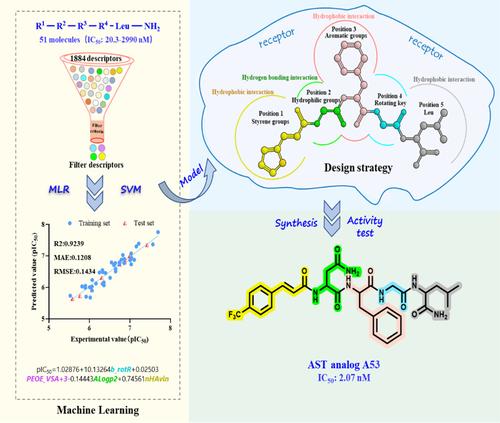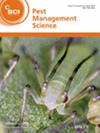求助PDF
{"title":"基于机器学习的合理设计,高效发现有希望成为新型 IGR 候选先导药物的别他司汀类似物","authors":"Yi‐Meng Zhang, Qi He, Jia‐Lin Cui, Yan Liu, Mei‐Zi Wang, Xing‐Xing Lu, Shi‐Xiang Pan, Chandni Iqbal, De‐Xing Ye, Wen‐Yu Sun, Xin‐Yuan Zhang, Zhen‐Peng Kai, Li Zhang, Xin‐Ling Yang","doi":"10.1002/ps.8518","DOIUrl":null,"url":null,"abstract":"BACKGROUNDInsect neuropeptide allatostatins (ASTs) play a vital role in regulating insect growth, development, and reproduction, making them potential candidates for new insect growth regulators (IGRs). However, the practical use of natural ASTs in pest management is constrained by their long sequences and high production costs, thus the development of AST analogs with shorter sequences and reduced cost is essential. Traditional methods for designing AST analogs are often time‐consuming and resource‐intensive. This study aims to employ new computational methodologies to understand the structure–activity relationship and efficiently discover potent AST analogs.RESULTSTwo machine learning models, utilizing multiple linear regression and support vector machine, were constructed to reveal the key structural factors that influence the juvenile hormone‐inhibiting activity of AST analogs. These models suggested that a potent AST analog should contain styrene, hydrophilic, and aromatic groups, and rotatable bonds at positions 1, 2, 3, and 4, respectively. Six analogs (A52‐A57) were designed and synthesized, and they exhibited potent juvenile hormone‐inhibiting activity (IC<jats:sub>50</jats:sub> < 16 nM). Notably, analog A53 showed the best activity (IC<jats:sub>50</jats:sub> = 2.07 nM), surpassing that of most natural <jats:italic>Dippu</jats:italic>‐ASTs, making it a potential lead candidate for IGRs.CONCLUSIONThese models promote the efficient design, screening, and prioritization of new or untested AST analogs. The study clarifies how a machine learning‐based strategy facilitates the development of AST analogs as novel IGR lead candidates, offering a useful reference for pest management. © 2024 Society of Chemical Industry.","PeriodicalId":218,"journal":{"name":"Pest Management Science","volume":"147 1","pages":""},"PeriodicalIF":3.8000,"publicationDate":"2024-11-08","publicationTypes":"Journal Article","fieldsOfStudy":null,"isOpenAccess":false,"openAccessPdf":"","citationCount":"0","resultStr":"{\"title\":\"Machine learning‐based rational design for efficient discovery of allatostatin analogs as promising lead candidates for novel IGRs\",\"authors\":\"Yi‐Meng Zhang, Qi He, Jia‐Lin Cui, Yan Liu, Mei‐Zi Wang, Xing‐Xing Lu, Shi‐Xiang Pan, Chandni Iqbal, De‐Xing Ye, Wen‐Yu Sun, Xin‐Yuan Zhang, Zhen‐Peng Kai, Li Zhang, Xin‐Ling Yang\",\"doi\":\"10.1002/ps.8518\",\"DOIUrl\":null,\"url\":null,\"abstract\":\"BACKGROUNDInsect neuropeptide allatostatins (ASTs) play a vital role in regulating insect growth, development, and reproduction, making them potential candidates for new insect growth regulators (IGRs). However, the practical use of natural ASTs in pest management is constrained by their long sequences and high production costs, thus the development of AST analogs with shorter sequences and reduced cost is essential. Traditional methods for designing AST analogs are often time‐consuming and resource‐intensive. This study aims to employ new computational methodologies to understand the structure–activity relationship and efficiently discover potent AST analogs.RESULTSTwo machine learning models, utilizing multiple linear regression and support vector machine, were constructed to reveal the key structural factors that influence the juvenile hormone‐inhibiting activity of AST analogs. These models suggested that a potent AST analog should contain styrene, hydrophilic, and aromatic groups, and rotatable bonds at positions 1, 2, 3, and 4, respectively. Six analogs (A52‐A57) were designed and synthesized, and they exhibited potent juvenile hormone‐inhibiting activity (IC<jats:sub>50</jats:sub> < 16 nM). Notably, analog A53 showed the best activity (IC<jats:sub>50</jats:sub> = 2.07 nM), surpassing that of most natural <jats:italic>Dippu</jats:italic>‐ASTs, making it a potential lead candidate for IGRs.CONCLUSIONThese models promote the efficient design, screening, and prioritization of new or untested AST analogs. The study clarifies how a machine learning‐based strategy facilitates the development of AST analogs as novel IGR lead candidates, offering a useful reference for pest management. © 2024 Society of Chemical Industry.\",\"PeriodicalId\":218,\"journal\":{\"name\":\"Pest Management Science\",\"volume\":\"147 1\",\"pages\":\"\"},\"PeriodicalIF\":3.8000,\"publicationDate\":\"2024-11-08\",\"publicationTypes\":\"Journal Article\",\"fieldsOfStudy\":null,\"isOpenAccess\":false,\"openAccessPdf\":\"\",\"citationCount\":\"0\",\"resultStr\":null,\"platform\":\"Semanticscholar\",\"paperid\":null,\"PeriodicalName\":\"Pest Management Science\",\"FirstCategoryId\":\"97\",\"ListUrlMain\":\"https://doi.org/10.1002/ps.8518\",\"RegionNum\":1,\"RegionCategory\":\"农林科学\",\"ArticlePicture\":[],\"TitleCN\":null,\"AbstractTextCN\":null,\"PMCID\":null,\"EPubDate\":\"\",\"PubModel\":\"\",\"JCR\":\"Q1\",\"JCRName\":\"AGRONOMY\",\"Score\":null,\"Total\":0}","platform":"Semanticscholar","paperid":null,"PeriodicalName":"Pest Management Science","FirstCategoryId":"97","ListUrlMain":"https://doi.org/10.1002/ps.8518","RegionNum":1,"RegionCategory":"农林科学","ArticlePicture":[],"TitleCN":null,"AbstractTextCN":null,"PMCID":null,"EPubDate":"","PubModel":"","JCR":"Q1","JCRName":"AGRONOMY","Score":null,"Total":0}
引用次数: 0
引用
批量引用
Machine learning‐based rational design for efficient discovery of allatostatin analogs as promising lead candidates for novel IGRs
BACKGROUNDInsect neuropeptide allatostatins (ASTs) play a vital role in regulating insect growth, development, and reproduction, making them potential candidates for new insect growth regulators (IGRs). However, the practical use of natural ASTs in pest management is constrained by their long sequences and high production costs, thus the development of AST analogs with shorter sequences and reduced cost is essential. Traditional methods for designing AST analogs are often time‐consuming and resource‐intensive. This study aims to employ new computational methodologies to understand the structure–activity relationship and efficiently discover potent AST analogs.RESULTSTwo machine learning models, utilizing multiple linear regression and support vector machine, were constructed to reveal the key structural factors that influence the juvenile hormone‐inhibiting activity of AST analogs. These models suggested that a potent AST analog should contain styrene, hydrophilic, and aromatic groups, and rotatable bonds at positions 1, 2, 3, and 4, respectively. Six analogs (A52‐A57) were designed and synthesized, and they exhibited potent juvenile hormone‐inhibiting activity (IC50 < 16 nM). Notably, analog A53 showed the best activity (IC50 = 2.07 nM), surpassing that of most natural Dippu ‐ASTs, making it a potential lead candidate for IGRs.CONCLUSIONThese models promote the efficient design, screening, and prioritization of new or untested AST analogs. The study clarifies how a machine learning‐based strategy facilitates the development of AST analogs as novel IGR lead candidates, offering a useful reference for pest management. © 2024 Society of Chemical Industry.



